Pittsburgh is the second largest city in Pennsylvania. Only Philadelphia has more people. Pittsburgh lies in the rolling hills of southwestern Pennsylvania, where the Allegheny and Monongahela rivers meet and form the Ohio River. The city was founded in 1758 and eventually grew into a major center of industry and manufacturing.

Pittsburgh has gone through a number of changes. Early in its history, it was known as the site where the French and Indian War (1754-1763) broke out. Because the Ohio River was the major route into the North American heartland, both Britain (now also called the United Kingdom) and France wanted to control the area. France lost nearly all of its North American land in the war.
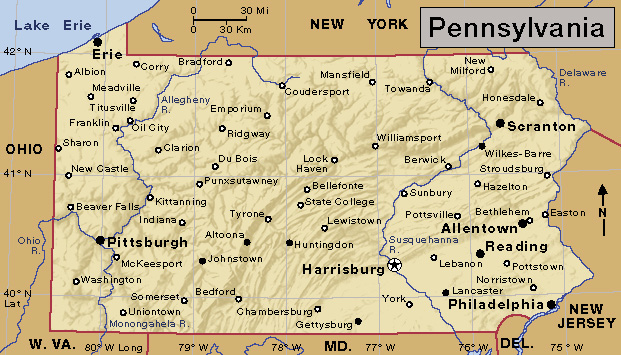
After the American Revolution (1775-1783), Pittsburgh became known as the Gateway to the West because people stopped there on their way west into the United States interior. During the late 1800’s, Pittsburgh became known as the Steel City, as no other city produced more iron and steel. Steel from Pittsburgh was used to build the Brooklyn Bridge, railroads, and U.S. armaments (war supplies).
Steel production gave Pittsburgh a booming economy. However, industry and coal-burning furnaces in homes caused severe pollution. At times during the 1940’s, the air became so dirty that downtown streetlights had to be turned on during daytime. Some people mocked Pittsburgh as the “Smoky City.” In the early 1950’s, Pittsburgh began a major urban renewal program that became known as the Pittsburgh Renaissance. Stricter controls on industry and coal-burning furnaces greatly reduced pollution. In addition, dams were built along the rivers to control flooding.
During the 1970’s and 1980’s, most of the Pittsburgh area’s steel mills closed. Pittsburgh’s identity then changed again, as sports replaced steel as the city’s trademark. City leaders promoted Pittsburgh as the City of Champions.
During the late 1900’s and early 2000’s, the city’s economy rebounded and became more diversified (varied). Service industries—especially in the health and medical, education, and high-technology fields—increased in importance. Bike trails, parks, and residences replaced factories along the rivers, and the city began drawing attention for its quality of life.
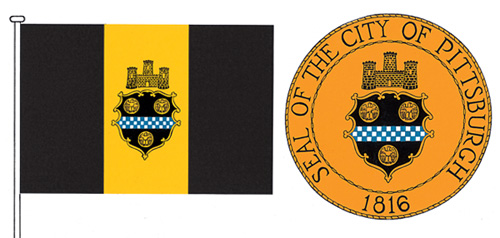
The city
Layout of Pittsburgh.
Pittsburgh lies in the center of Allegheny County. Much of downtown Pittsburgh stands in a wedge-shaped area between the fork of the Allegheny and Monongahela rivers. This area, called the Golden Triangle, features skyscrapers that house offices, residences, and shops. Most of Pittsburgh’s major corporations have their headquarters in or near there. They include PNC Financial Services, PPG Industries, and United States Steel Corporation. The 64-story U.S. Steel Tower is one of the tallest buildings in Pennsylvania.
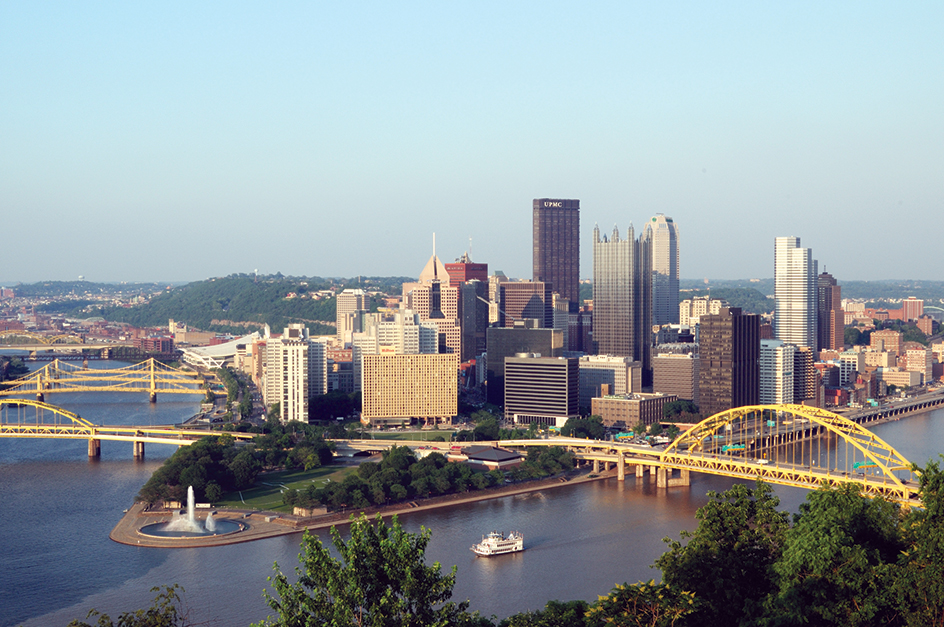
The western tip of the Golden Triangle—where the Ohio River begins—is called the Point. During the first half of the 1900’s, the Point was an Irish American neighborhood. It was crowded with factories, warehouses, and other buildings. After a fire in 1946, the neighborhood was torn down to make way for an urban renewal program. In its place, developers established Point State Park, a hotel, and a complex of office buildings.
A hill called Mount Washington overlooks downtown Pittsburgh from across the Monongahela River. It rises 450 feet (137 meters) and stretches for several miles along the river. Mount Washington features observation decks and restaurants that offer spectacular views of Pittsburgh and its three rivers. Two small cable car lines, called “inclines” by Pittsburghers, carry visitors up and down Mount Washington.
Residential areas spread out beyond downtown. Industrial activity is scattered throughout the region. Large numbers of workers commute to and from downtown Pittsburgh. Most cross over some of the more than 450 bridges within the city.
The metropolitan area.
Pittsburgh’s metropolitan area covers Allegheny, Armstrong, Beaver, Butler, Fayette, Lawrence, Washington, and Westmoreland counties. Hempfield is Pittsburgh’s largest suburb. Other big suburbs include Bethel Park, Mount Lebanon, and Penn Hills.
The Pittsburgh metropolitan area includes a number of communities that, like Pittsburgh itself, formerly depended on the production of steel. These communities include Braddock, Duquesne, Homestead, and McKeesport. When their mills closed or reduced operations, the towns suffered economically.
People
Ethnic groups.
Early in its history, Pittsburgh attracted people from England, Scotland, and Northern Ireland. Large numbers of German and Irish immigrants joined them in the mid-1800’s. After 1880, many immigrants from eastern, southern, and central Europe came to the city. The city’s Asian, Hispanic, and multiracial populations increased during the early 2000’s. Today, several Pittsburgh neighborhoods, such as Polish Hill, still have strong ethnic identities.
Large numbers of African Americans began moving to Pittsburgh in the early 1900’s. In the 1930’s and 1940’s, Pittsburgh’s Hill District was one of the most prosperous African American communities in the United States. Today, African Americans account for about a fourth of Pittsburgh’s population. Although the Hill is still the central Black neighborhood, many African Americans live in public housing projects, in neighborhoods around the city, and in the suburbs, including Penn Hills, Wilkinsburg, and Monroeville.
Housing.
Pittsburgh’s East End includes well-kept neighborhoods with housing ranging from relatively inexpensive duplexes to lavish mansions. Part of the North Side includes houses that are more than 100 years old. They have been restored to reflect their original condition and beauty. Crawford Square is a development of single-family homes, town houses, and apartments on the lower Hill, close to downtown. The city government and private developers worked together to build it. Some of the older homes near downtown stand on the steep hillsides. The hills are so steep that many buildings are two stories high in front and four or more stories in back.
Education.
An elected Board of Directors supervises the public schools of Pittsburgh. Pittsburgh’s Roman Catholic diocese also operates a number of elementary and high schools. The Pittsburgh area is a center of higher education. Its top institutions include the University of Pittsburgh, the area’s largest school of higher education, and Carnegie Mellon University, a leading research institution. Other institutions of higher education include Pittsburgh Theological Seminary and Carlow, Chatham, Duquesne, La Roche, Point Park, and Robert Morris universities.
Cultural life
The arts.
Few cities of comparable size have as rich a cultural life as Pittsburgh. Many Pittsburgh residents who became wealthy in industry and banking used their fortunes to support the arts, museums, and other cultural offerings. The steel manufacturer Andrew Carnegie, for instance, founded numerous cultural, educational, and scientific institutions.
The Pittsburgh Symphony Orchestra performs downtown at Heinz Hall for the Performing Arts. The nearby Benedum Center for the Performing Arts hosts performances by the Pittsburgh Ballet Theatre, Pittsburgh Opera, Pittsburgh Dance Council, and Civic Light Opera. The Pittsburgh Public Theater offers professional regional theater. The Three Rivers Arts Festival, held each June in the Golden Triangle, features works by painters, sculptors, and musicians. The Pavilion at Star Lake in Washington County presents outdoor concerts.
Museums and libraries.
The Carnegie Museums of Pittsburgh are a collection of four museums. The Carnegie Museum of Natural History features collections of dinosaur fossils. The Carnegie Museum of Art includes the Heinz Architectural Center and Hall of Architecture. The Carnegie Science Center presents science shows and other programs. The Andy Warhol Museum houses many of the most famous works by Warhol, a major Pop artist who was born in Pittsburgh.
The Senator John Heinz History Center features the Western Pennsylvania Sports Museum and exhibits on the area’s history. Carnegie Library of Pittsburgh is the city’s public library. The Carnegie library system includes a main library and several branches.
Recreation.
The Pittsburgh area has dozens of parks, fields, and playgrounds. Schenley Park is one of Pittsburgh’s largest parks. It includes the Phipps Conservatory and Botanical Gardens, which house a rich collection of plants and flowers in one of the few remaining Victorian greenhouses in the United States. Highland Park is home of the Pittsburgh Zoo & PPG Aquarium. The National Aviary in Pittsburgh houses a wide variety of birds in a natural setting with plants, pools, and waterfalls. Exhibits at the Children’s Museum of Pittsburgh encourage personal participation. Several large county parks in suburban areas offer biking, hiking, horse riding, swimming, and ice skating. Kennywood, a historic amusement park in West Mifflin, is famous for its fast roller coasters.
Every summer, the Three Rivers Regatta draws spectators downtown to see speedboat races and fireworks. The Head of the Ohio Regatta, a major annual race, takes place each fall. The riverboats of the Gateway Clipper Fleet offer dining, dancing, and sightseeing tours of downtown. Fort Necessity National Battlefield, south of Pittsburgh in Farmington, marks the site of the Battle of Fort Necessity of 1754. The battle was one of the first of the French and Indian War.
During the 1970’s, when baseball’s Pittsburgh Pirates and football’s Pittsburgh Steelers won multiple championships, Pittsburgh became known as the City of Champions. The Pittsburgh Penguins—winners of multiple National Hockey League titles in the 1990’s and early 2000’s—also play in the city.
Economy
The economy of the Pittsburgh area went through a major change in the 1980’s. Previously, it had been dependent on heavy industry—notably steel production. However, heavy industry declined, and many of the mills and other factories closed down. Unemployment rose as a result. Eventually, the development of other economic activities helped improve Pittsburgh’s economic conditions. Today, health care and education contribute heavily to the area’s economy. Financial services, research and development, and tourism also employ large numbers of workers. Manufacturing still employs tens of thousands of people in the region, but it no longer dominates the economy.
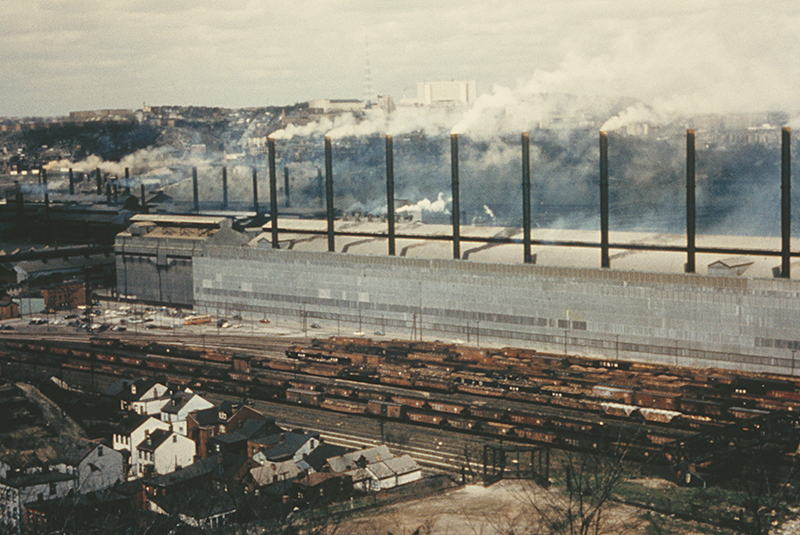
Manufacturing.
Pittsburgh’s steel mills formerly produced all kinds of steel. Today’s remaining mills chiefly turn out specialty steel, which is used to make tools and automobiles. This type of steel is of higher quality and more profitable than types made in earlier years. Pittsburgh factories also produce glass products, fabricated metals, chemicals, and machinery.
Pittsburgh’s largest private employers include Alcoa, a major aluminum producer; United States Steel Corporation, a leading steelmaker; and PPG Industries, a glass, paint, and chemical manufacturer. The H. J. Heinz Company makes ketchup, pickles, and other food products.
Service industries.
The Pittsburgh area ranks as a major center of health care. Scores of hospitals serve the area. The University of Pittsburgh Medical Center specializes in liver, kidney, heart, and lung transplants.
Research and development is also a major service industry. A large number of academic, industrial, and governmental research laboratories operate in the Pittsburgh area. Their engineers, scientists, and technicians work in such fields as medical technology, computer software programming, and industrial automation.
Transportation and communication.
Pittsburgh International Airport is in southwestern Allegheny County. Major railroads and interstate highways also serve the city. A trolley-subway connects downtown with the southern suburbs. Pittsburgh’s rivers are used to ship raw materials to, and finished products from, the city.
Pittsburgh has one daily newspaper, the morning Pittsburgh Post-Gazette. The Tribune-Review in nearby Greensburg also publishes a Pittsburgh edition. Several smaller daily newspapers published in towns surrounding Pittsburgh serve the area’s suburban population. KDKA became one of the first commercial radio stations in the United States when it began broadcasting in 1920. For more details, see Radio (The start of broadcasting).
Government
The city of Pittsburgh has a mayor-council form of government. Voters elect the mayor and the nine council members to four-year terms. Most of the city’s revenues come from a wage tax and property taxes. In the 1990’s, to reduce its spending, the city turned over three city institutions to private groups to own and manage. The three were the Pittsburgh Zoo, the Phipps Conservatory and Botanical Gardens, and the National Aviary in Pittsburgh. Pittsburgh is the seat of Allegheny County.
In addition to the city government, the Pittsburgh area has dozens of other government bodies. They include suburban municipal governments, local boards of education, and county government.
History
Early days.
The earliest inhabitants of what is now the Pittsburgh area were Native Americans. The Iroquois of western New York chased the original tribes out of the area in the 1600’s. In the 1740’s, French soldiers claimed the area for the king of France. Many Native Americans traded goods with French and Canadian traders.
Both Britain (now also called the United Kingdom) and France sought to gain control of the region, and this competition led to the French and Indian War (1754-1763). In 1754, French troops built Fort Duquesne at the junction of the Allegheny and Monongahela rivers. George Washington—who at that time was a 22-year-old lieutenant colonel in the militia of the British colony of Virginia—built Fort Necessity south of Fort Duquesne. The French defeated Washington’s troops in the Battle of Fort Necessity and forced Washington to surrender the fort. The battle marked one of the first military actions of the French and Indian War.
In spite of their early defeat, the British won control of the Pittsburgh area in 1758. They built Fort Pitt—named in honor of the British statesman William Pitt, the Earl of Chatham—near the fork of the Allegheny and Monongahela rivers. A settlement grew up around the fort and became Pittsburgh.
The American colonists won independence from Britain in the American Revolution (1775-1783). After the war, Pittsburgh became a starting point for pioneers traveling west. Pittsburgh became the Allegheny County seat in 1788 and was incorporated as a borough in 1794.
Industrial development.
Demands from Western settlements for manufactured goods caused industry to grow rapidly in Pittsburgh. The city was incorporated in 1816. At that time, it had a population of about 5,000. Nearby deposits of coal and oil helped make Pittsburgh an ironmaking and glassmaking center by the mid-1800’s.
Transportation developments also helped industry grow in Pittsburgh. Flatboats, keelboats, and steamboats built in the city carried settlers and goods down the Ohio and Mississippi rivers in the early 1800’s. The Pennsylvania Canal System, which connected Pittsburgh and Philadelphia, opened its main line in 1834. A railroad entered Pittsburgh in 1851. By then, more than 46,000 people lived in the city.
The American Civil War (1861-1865) created a great demand for arms and ammunition. Pittsburgh became a chief supplier for the Union Army. During the late 1800’s, steel manufacturers Andrew Carnegie and Henry Clay Frick built industrial empires in the city. Pittsburgh steel mills played an important role in America’s growth. They supplied great amounts of steel to build bridges, factories, and railroads.
Industrial growth attracted thousands of workers to Pittsburgh in the late 1800’s. Many came from Croatia, Hungary, Italy, and other parts of southern and central Europe. From 1870 to 1900, the city’s population more than tripled, jumping from 86,076 to 321,616. By 1900, half of the world’s glass and iron came from Pittsburgh’s factories. The city’s steel mills made two-thirds of the steel produced in the United States.
The early 1900’s.
In 1907, Allegheny City, on the north banks of the Allegheny River, merged with the city of Pittsburgh. The arrival of more immigrants from Europe and of Black people from the southern United States helped boost the population of Pittsburgh to 669,817 by 1930. In 1936, on St. Patrick’s Day, the Allegheny and Monongahela rivers flooded the Golden Triangle, causing 74 deaths and damaging thousands of homes.
World War II.
In December 1941, the United States joined the side of the Allies in their World War II fight against the Axis nations. From then until the Allied victory in September 1945, the Pittsburgh area’s mills and factories operated at full capacity to provide steel, glass, and other products for the war effort. During the war, Pittsburgh area mills turned out more steel than did the Axis countries of Germany and Japan combined.
Also during World War II, Pittsburgh became one of the first cities in the United States to construct large numbers of public housing units. Thousands of people had moved to the city to take jobs in its booming war-related industries. The inflow of people caused a housing shortage and led local and federal government to construct low-rent public housing for workers.
Urban renewal.
In 1946, Mayor David L. Lawrence, financier Richard K. Mellon, and other civic and corporate leaders began an urban renewal program in Pittsburgh that would become the first such program in the United States. The city started strict smoke-control and water pollution-control programs to clean up Pittsburgh’s polluted air and water. By the 1960’s, most of the clean-up efforts had been completed. Pittsburgh’s population peaked at 676,806 in 1950. In the 1950’s and 1960’s, many white residents moved out of the city to surrounding suburbs.
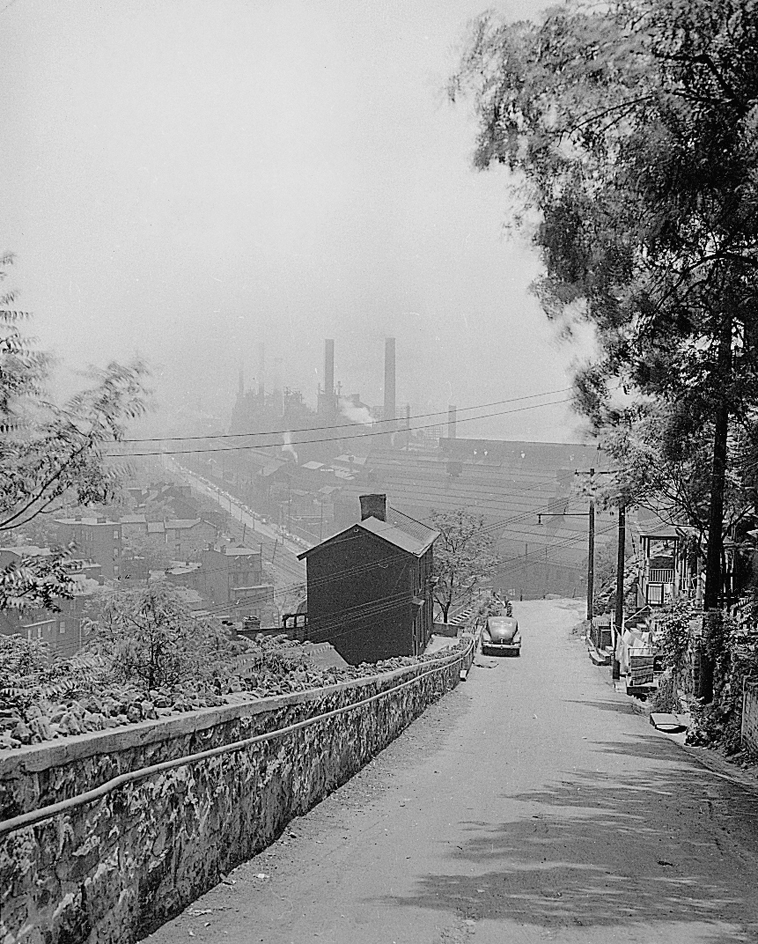
The first stage of urban renewal, known as the Pittsburgh Renaissance, ended in the early 1970’s. It focused on the downtown and included a new sport and entertainment arena on the lower Hill. A second Renaissance began during the 1980’s. It produced a convention center, a trolley-subway system, and several new skyscrapers, including PPG Place.
Recent developments.
Between 1980 and 1990, the population of Pittsburgh dropped from 423,959 to 369,879, largely because of economic problems. Many young people in the area moved to other cities to find work. During the 1990’s, unemployment declined in the Pittsburgh area, as new jobs in health care and other occupations became available. Pittsburgh International Airport opened in 1992, adding to the area’s role as a transportation center. Despite these developments, Pittsburgh’s population continued to decline, to 302,971 in 2020.

